Paragliding Baptism: For whom? Where? When? How to do it?
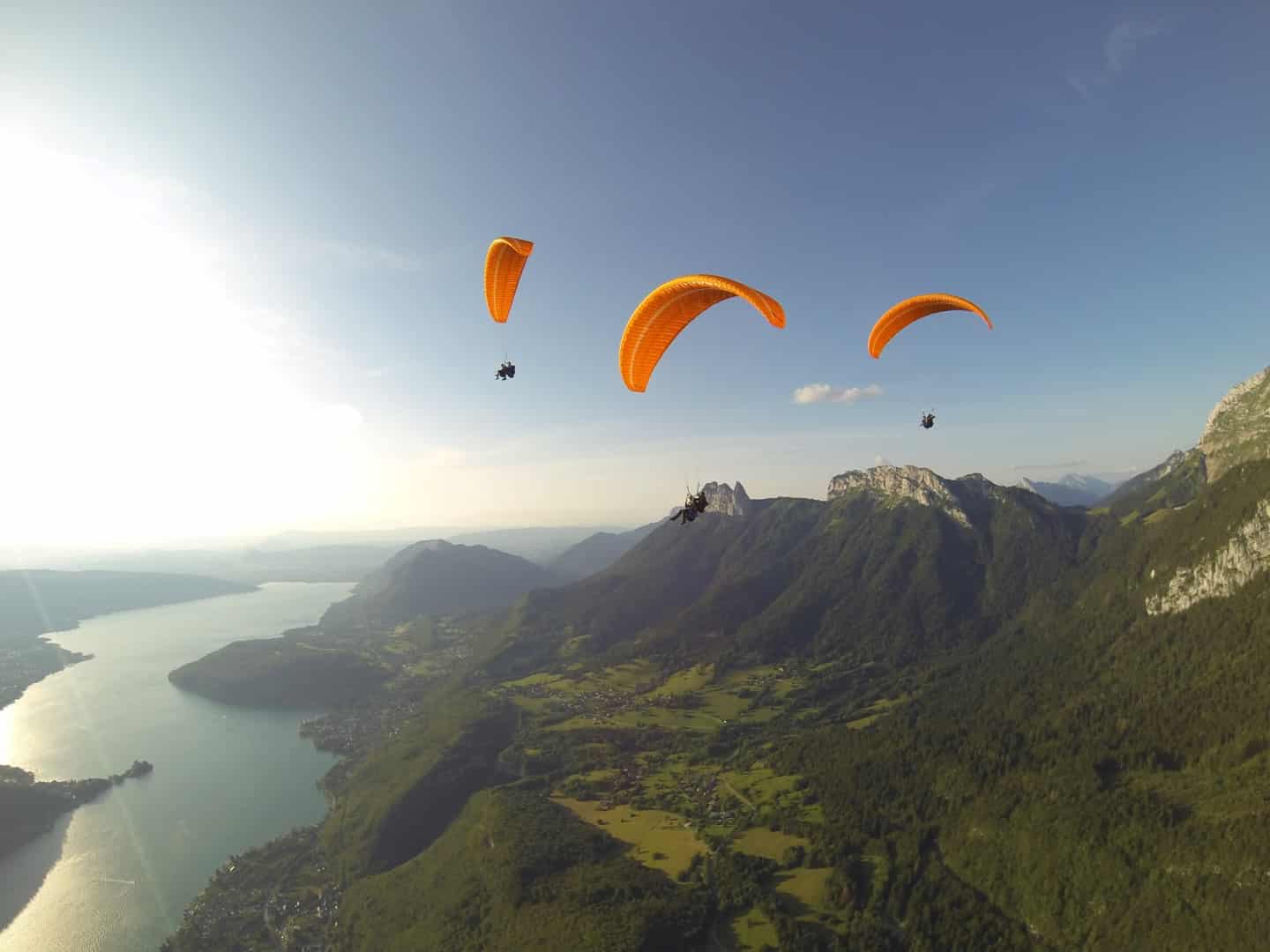
Flying like a bird, feeling the wind on your face and soaring over the most beautiful landscapes! All these sensations await you during a paragliding flight. Requiring little equipment - a harness, a cloth paraglider and good weather conditions - this activity can be practiced anywhere in the world and allows you to discover the most beautiful places from the air!
Are you tempted, but you have no experience of paragliding? No problem, the paragliding experience is for you! During this tandem flight you are attached to a certified pilot who takes care of everything, you just have to enjoy the sensations and the exceptional view. In order to know everything about tandem paragliding and to be as prepared as possible, we answer below the questions you may have.
Why do you want to go on a tandem paragliding flight?
It's a legitimate question! After all, there are many ways to enjoy the pleasures of the air and a beautiful view: skydiving, hang-gliding, microlighting, helicopter...
But of all these activities, paragliding has one advantage: it is by far the most accessible. In terms of time, money, and simplicity. And if you're not sure whether to take the plunge into real training, why not try a tandem paragliding flight?
What is a discovery paragliding flight?

The open flight is done in tandem with a certified and professional paragliding instructor. You fly over beautiful landscapes and let yourself be carried by the wind. Your instructor guides the flight with the directional levers while you watch the world go by under your feet... Happiness!
The paragliding experience is particularly comfortable. You are seated in a harness specially designed for tandem flight that is attached directly to your instructor. This harness acts as a seat in which you can sit back and enjoy the flight.
Flying a tandem paraglider gives you a first taste of the pleasures of free flight without the need for training and in complete safety. You can concentrate on your feelings alone and enjoy the moment by leaving it completely to the paragliding instructor or by starting to take the controls if you feel comfortable.
Observation of the landscape, fauna and flora by paragliding

A paragliding experience gives you plenty of time to look around and especially under your feet! The environment in which your paragliding flight will take place is therefore of prime importance.
No matter where you go on a tandem flight, you will discover incredible landscapes from a completely new and unique perspective. Your paragliding instructor, as a flight expert, knows the map of the area like the back of his hand. He flies over the same places regularly and therefore knows where to direct the paraglider so that you can discover the wildlife of the area. He will share with you the most beautiful tandem paragliding spots and show you the animals and birds and help you identify them.
Mountain scenery:From your height, you can see the snow-covered peaks and glaciers, and if you look down, you can see the valleys. The mountain fauna can be observed very well during a paragliding experience, as it evolves on the passes and slopes, in the open. In summer as well as in winter, you will easily see ibex and marmots. Paragliding in spring is particularly pleasant in the mountains as you can discover the flora that is awakening and the thousand colours of the high altitude flowers.
Plainscape:You fly over fields and forests. You can have fun identifying the surrounding towns and villages or spot lakes and rivers. Finally, you don't have to be a bird to enjoy the view from above!
Forest Landscape:A tandem flight through a forest is impressive! What could be more magical than flying over the treetops? You can see different tree species and maybe even some animals in the clearings!
Seaside scenery:Flying over a seaside area is as beautiful as it is varied. Between sea and land, a breathtaking view of the coastline and the ocean as far as the eye can see is offered to you. The landscapes can be very different, from flying over the Dune du Pilat, to flying over the majestic cliffs of Normandy and the white sandy beaches and turquoise water of Tahiti.
Flying over an Island:This is perhaps the richest environment in which you can make your first paragliding flight! Indeed, the relief is generally very varied on the islands and you will have a unique point of view on the ground which is cut out in the middle of the ocean. If you decide to go to Reunion or Guadeloupe, the colour of the water, the volcanoes and primary forests will offer you a dreamlike vision, surpassing all postcards. In this case, don't forget to have a look at our article dedicated to paragliding in Reunion Island.
How does a paragliding experience work?
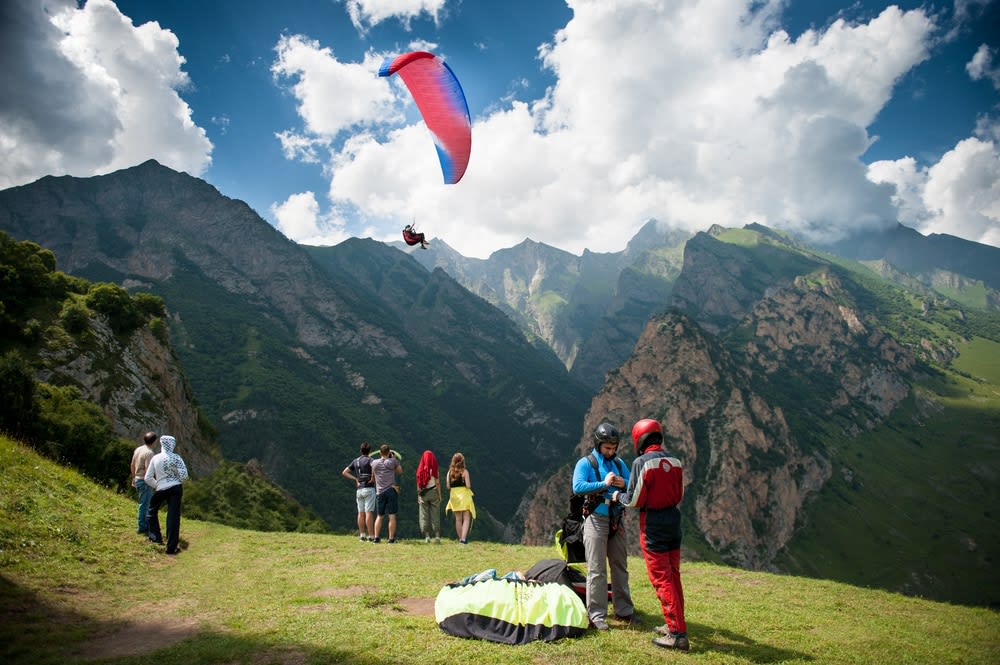
A tandem paragliding flight is particularly easy to organise for the passenger and ideal for discovering the activity!
The duration of a paragliding flight depends mainly on the wind. If the wind is strong enough at the time of your flight, you will be able to glide along and let the air currents carry you for longer. In the afternoon, you will generally enjoy longer flights thanks to thermals (warm winds that allow you to gain height).
The route taken by your paragliding instructor will depend mainly on the wind direction, but he will generally try to take you to the most beautiful flying spots.
A tandem paragliding flight is usually conducted as follows:
1. Meet your instructorYou meet your paragliding instructor at a designated meeting point. Often this is at the paragliding school, but sometimes you may have to meet him/her directly at the start of a ski lift or in a car park near the take-off area.
2.Your instructor will take you to the take-offpoint (summit, hill, etc.) from where you will take off. Most schools have shuttle buses to take you to the launch site in groups. It is also possible, especially in the mountains, that you use the ski lifts to reach a pass. If the take-off area is close to a road and sufficiently equipped then you will be right next to it.
3. Youwill put on your harness with the help of your certified instructor who will then check the fastenings. The instructor will then explain the safety instructions and the course of the flight. He will also brief you on the weather and wind conditions so that you start to get an idea of the elements that can influence a paragliding flight. The instructor will then set up the paraglider and come and hold on to you.
4. Take off and enjoyThe big moment has come! The instructor quickly explains what you have to do for take-off. You run with the instructor for a few meters (or slide on skis for a winter flight) to gain momentum and... It's take-off! The paraglider takes off and carries you with it gently. The freedom of flight and the pleasure of discovering the landscape under your feet are yours.
5. Landing and returnAfter long and rewarding minutes of paragliding and happiness in the harness, it is time to put your feet up. The instructor controls the wing to make the landing as smooth as possible and will remind you during the descent what position to adopt and what attitude to have in the last few metres before touching down. It is then time to return to the cars. Depending on the landing site, there may be a shuttle bus available to take you back. Often you will land next to your meeting point and just have to walk back to get your souvenir photos!
Questions & Answers on Paragliding Baptism
Now you know how a tandem paragliding flight works and which landscapes you can fly over. But you probably still have questions about who can do a tandem paragliding flight, what kind of flight to choose and which are the best spots. You can find all the answers to these questions in our Questions & Answers section.
Who can do a tandem paragliding flight?

The answer is simple: absolutely anyone can take part in a tandem paragliding flight! Really!
Young and old, adults, children and grandparents, everyone can enjoy paragliding with a professional paragliding instructor. Tandem paragliding equipment is extremely varied and can be adapted to all body types. Some paragliding schools also offer flights for disabled people with a special tandem harness, so there is no need to be jealous!
However, there are certain limitations to a first paragliding experience. Depending on the school, the maximum weight of the passenger in a tandem flight varies between 90 kilos and 120 kilos depending on the equipment they have available. It is important to know that the weight does not prevent you from flying, but it may change the duration of the flight as you may descend more quickly.
Paragliding centres often offer discovery flights for children of all ages who would like to make their wildest dreams come true by flying among the birds. As long as they are willing and unafraid, you can offer them a paragliding experience without fear and perhaps allow them to reveal a real passion for the air!
The only prerequisite for a tandem paraglider flight is to be able to make the few metres of run-up at take-off: either by running (most of the time) or on skis during winter flights. Don't panic, it's only a matter of a few strides over ten metres or so while the wind rushes through the wing.
How to choose a tandem paragliding flight?
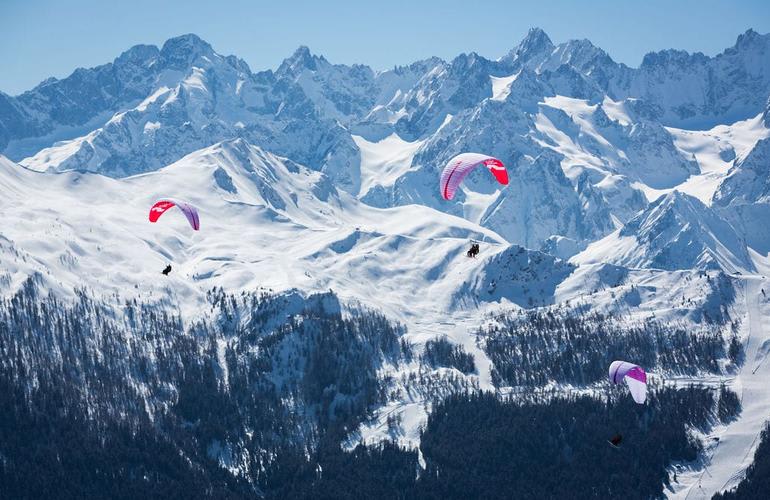
In order to choose the right paragliding flight, you must first of all take into account your own desires! Start by choosing the spot for your paragliding flight. As mentioned above, you can fly in tandem anywhere in the world and over a wide variety of landscapes. The different take-off points in France and in the world offer you infinite possibilities of flight! Discover all our more than 480 paragliding flights all over the world.
In addition to the location you can choose between different types of flights. The main question is whether you want your first flight to be like a rollercoaster or a leisurely ride in the wind. Daredevils are more likely to go for thermal flights or acrobatic flying, which is often called "sensation flying" by free flight schools and is aptly named. However, if you are on holiday in a special place, for example, then you may want to opt for thermal or scenic flying. You are more likely to stay in the air longer and enjoy it more.
Here are the different types of paragliding flights:
- Discovery: quiet, relaxing, focused on the observation of the landscape and the discovery of the first sensations of flight.
- Sensation: a sporty flight where the focus is on the thrill of the paragliding instructor. He will make you do many paragliding tricks such as spins, 360s or tight turns.
- Panoramic: You usually take off from a particularly high and already sensational peak. You fly for long minutes at high altitude and enjoy a breathtaking view of the landscape. These flights are majestic and you'll get a great view!
- Thermal: these flights take place in the afternoon, when the air warms up. The principle is simple: use the warm air currents or updrafts to gain height and fly further and longer. You can therefore see more with a thermal flight than with a simple flight.
How does tandem flying feel?
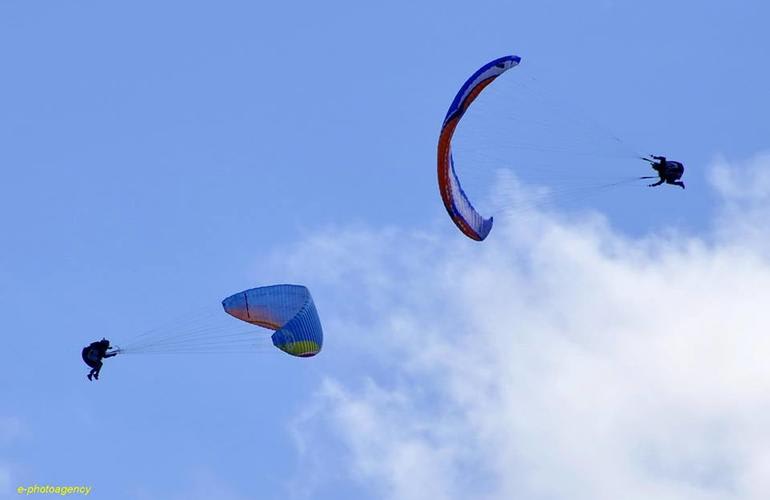
The first question you may ask yourself is: can you be afraid of heights during a paragliding flight? The answer is simple, there is no such thing as vertigo! As long as you don't have a physical reference point to the ground (which is what happens once you are in the air), your brain no longer perceives the void in the same way. Of course, it is possible to be apprehensive about flying, but this is a slight concern that will pass quickly once your instructor has briefed you. This is one of the particularities of this free flight activity that makes it so accessible to the general public.
In general, a paragliding flight lets you experience what birds feel as they soar above the clouds all day. You will feel the wind lift you up and carry you along with the currents. Your instructor is there to make you aware of the influence of the wing's movements on the direction and usually starts explaining the basic manoeuvres of solo paragliding. If you are comfortable, he will give you the controls so that you can start to experience the wind yourself under his constant supervision.
In the more athletic and acrobatic paragliding flights, the emphasis is on thrills and spills, where you can feel the wind whip across your face and your guts clench in the tight spins and turns. The sensation of freefall is rare in paragliding as the instructor relies mainly on speed to create the tricks. If you miss roller coasters, then you won't be disappointed by paragliding!
There is nothing more exhilarating than freedom. In paragliding, that's exactly the feeling you'll find. Not touching the ground and flying calmly through the air is soothing. You will feel a sense of fulfilment and you will only want the flight to last longer and longer, so that you no longer feel the weight of your own body or of everyday life on your shoulders... Happiness!
When is the best time to do a tandem flight?

Depending on the paragliding spots, it is possible to fly all year round and at any time of day. Generally speaking, paragliding flights take place between April and November. It is then possible to fly in the morning or in the afternoon, on rotations of about 1 to 2 hours depending on the duration of the flight.
In the afternoon, the warm, thermal winds allow for a longer flight time and more height to see the surroundings. The morning, however, offers you flights in a fresh, mysterious and barely awake landscape. Ask about sunrise or sunset flights to add a touch of sunshine to your paragliding experience.
Winter paragliding flights are particularly original. You take off in the snow and slide down on skis to gain speed and allow the paraglider wing to inflate! The sensation of taking off and landing (still on skis) is unique! On top of that, you fly over immaculate landscapes where peace and silence reign. And for a more sporty winter activity, discover Speedriding, a mix of paragliding, skiing and adrenaline.
What equipment do I need for a tandem flight?
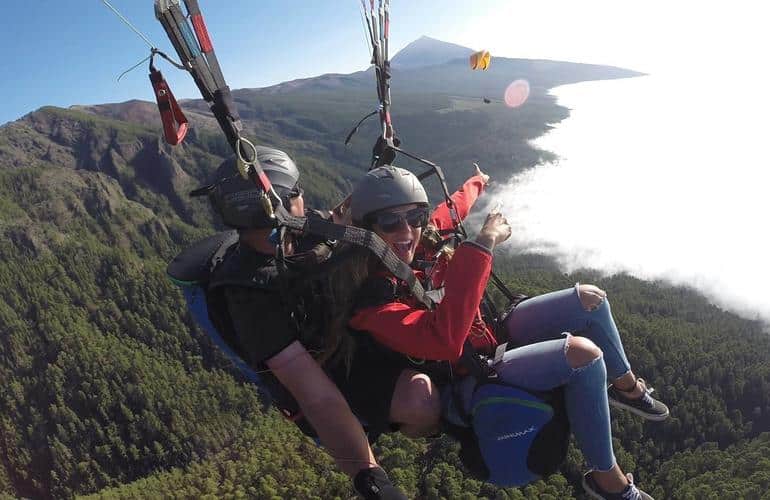
Paragliding equipment is always provided by the school. This does not prevent you from planning your own outfit for your first paragliding experience.
You will always have to adapt to the weather in different seasons. It is important to bear in mind that the air is always cooler at higher altitudes and that the wind can sometimes become cooler during your paragliding flight. Paragliding exposes you entirely to the vagaries of the wind, there is no protective shell to shield you. You must therefore be well covered at all times.
In winter, of course, it is advisable to fly in ski clothing, which will keep you warm and protect you from draughts. Gloves and a scarf are imperative in cold conditions.
In spring and autumn, when the weather is good and you're walking around in a jumper, you tend to want to stay that way to enjoy the sun's rays... It's best to bring at least a windproof coat to protect you from the cool winds that can blow at altitude.
In summer, while it may be tempting to stay in a tank top and shorts, beware! It can be chilly during the flight and a fleece with light trousers should help you withstand the wind more easily.
For all occasions: closed shoes. It is best to wear trainers, which will allow you to run at your ease to gain momentum and land smoothly on the grass.
What is the price of a paragliding experience?

A tandem flight is an ideal way to discover the activity and is particularly accessible to all. The price of a flight can vary enormously depending on the options chosen, the spot or the flight chosen. The first prices for a single tandem flight of about 15 minutes start mostly from 50 €. For longer flights to world-famous spots, the price can go up to €150.
There is also the option of taking photos and videos that you cannot take yourself for safety reasons. Photos and videos of a paragliding flight generally cost between 15 € and 50 € depending on the quality of the equipment used.
A paragliding experience can be a great birthday or holiday gift. With a tandem flight you offer an unforgettable experience! If there are several of you who would like to take a paragliding experience, don't hesitate to ask the paragliding school. Maybe they offer group rates or special prices.
Do you need a licence for a tandem paragliding flight?
The schools listed have the necessary insurance to accompany tandem paragliding flights. As long as you have your own insurance, there is no need to worry about tandem paragliding.
As far as the training is concerned, you can do your first paragliding experience with your hands in your pockets. You will not be asked for a licence to fly and all the instructions will be given to you on the spot for a safe experience. As you will be accompanied at all times by a qualified paragliding instructor, you can trust his teaching and control.
In a nutshell, a tandem paragliding flight is a magical experience! With all these tips and tricks to prepare your first flight, there is no reason to hesitate!
What are the best paragliding spots?

When it comes to places to go for your first paragliding experience, you are spoilt for choice! To help you in your decision, discover our Top 10 of the best tandem paragliding spots in Europe.Annecy is a paragliding mecca and offers an exceptional setting between the mountains and the lake to make your first tandem flight (see photo above).
For more inspiration check out all our paragliding destinations and articles.